Scroll down for images
With the major exhibition “Edgar Degas: A Strange New Beauty“, The Museum of Modern Art brings new focus to Hilaire-Germain-Edgar Degas’s (French, 1834–1917) extraordinary and rarely seen monotypes and their impact on his wider practice. On view March 26 through July 24, 2016, it is the first exhibition in the U.S. in nearly 50 years to examine these radical, innovative works—and MoMA`s first monographic exhibition of the artist.
Edgar Degas: A Strange New Beauty features approximately 120 monotypes along with some 60 related works, including paintings, drawings, pastels, sketchbooks, and prints. Organized by Jodi Hauptman, Senior Curator, Department of Drawings and Prints; with Karl Buchberg, Senior Conservator; and Heidi Hirschl, Curatorial Assistant, Department of Drawings and Prints, The Museum of Modern Art; and Richard Kendall, independent art historian and curator. MoMA is the sole venue for the exhibition.
A towering figure in 19th-century art, Degas is best known as a painter and chronicler of the ballet. Yet his work as a printmaker reveals the true extent of his restless creativity, as he mixed techniques with abandon in his studio and shared recipes with colleagues for producing unconventional effects. The monotype process involves drawing in black ink on a metal plate that was then run through a press, typically resulting in a single print. Captivated by the medium’s potential, Degas made more than 300 monotypes during two discrete bursts of activity, from the mid-1870s to the mid-1880s, and again during the early 1890s.
Taking the medium to new and radical ends, Degas abandoned the academic drawing of his youth, inventing a new repertoire of mark-making that included wiping, scraping, scratching, fingerprinting, and rendering via removal. Enigmatic and mutable forms, luminous passages emerging from deep blackness, and a heightened sense of tactility characterize the resulting works. The freedom Degas found in such techniques is an important theme of the exhibition, and the presentation links his efforts in monotype—the way he moves the printer’s ink with ease across the slick metal plate, resulting in a more liberated form of description—to works in other mediums.
Modern Life
For Degas, who was always searching for new means to describe new subjects, monotype proved to be the perfect medium to capture the essential features of modern urban life. The exhibition highlights Degas’s views of passersby on city streets, their faces blurred (Heads of a Man and a Woman, c. 1877–80), and bustling street scenes as figures cross paths (On the Street, 1876–77), along with signs of the era’s industry and commerce (Factory Smoke, 1877–79), the repetitive and arduous labor of Ironing Women (c. 1877–79), and the costumes of women lingering scandalously solo at cafés (Young Woman in a Café, c. 1877).
Of Degas’s urban subjects in monotype, it was the ballet and the café concert that offered the perfect melding of subject and means. In these works, Degas focused on fundamental aspects of the modern experience in an era of expanded entertainment, illumination, and motion. Degas once said that drawing dancers was just “a pretext for rendering movement,” a pictorial challenge that monotype gave him the means to address. While Degas’s images of the ballet take place on the stage as dancers leap into the air, as seen in Pas battu (c. 1879), they reflect the velocity and tempo of city life.
For late-19th-century urban dwellers experiencing the advent of 24-hour lighting, the city was always illuminated—and always in motion. Degas used the technical possibilities of the monotype to foreground the lighting of the ballet and café concert—gaslight and the new electric light. In works like Dancer Onstage with a Bouquet (c. 1876) or Café Singer (c. 1877–78), footlights transform the performer’s body, catching the translucency of tutus or turning faces into masks. In his café scenes, lighting is endlessly refracted in the theater’s mirrors and gilded architecture, creating an enchanted spectacle.
Backstage at the Ballet and in the Brothel
Degas used small-scale plates to portray the backstage at the ballet and the interiors of brothels in monotype. The exhibition includes a group of illustrations for The Cardinal Family, a collection of stories about the amorous adventures of two young ballerinas, written by Degas’s friend Ludovic Halévy.
Much of the action takes place backstage or in the theater’s wings, and Degas depicts the flurry and flux of backstage spaces by deploying gestural marks and smudges to suggest hustle and bustle, reflections in mirrors, and kaleidoscopic swirls of legs and arms, and by cropping bodies with the plate’s edge to imply motion. Seen together, these monotypes show Degas’s ever-active eye shifting from long views to close-ups, focusing on the empty centers of waiting rooms, and pressing close to the dancers as if taking on the vantage point of their male admirers. Although Degas’s illustrations were not used for the book’s initial publication, they demonstrate that narrative was a springboard for experimentation.
Bathers
Degas’s most daring application of monotype is in his depictions of female bathers in intimate settings. In these works, he deploys radical compositional and technical innovation, portraying private acts of washing and grooming and dramatically illuminating bodies and surroundings. Degas contorted these bathers into awkward, unusual, and seemingly impossible poses. Degas’s renderings are tactile, rough, and unresolved, with ambiguous contours blurring distinctions between body and environment.
Degas created these images primarily by subtraction—laying down a curtain of ink on the plate, he drew by removal, conjuring an image out of darkness by wiping the ink away with a process that has come to be known as the “dark-field” technique. Broadening his tool kit, he used brushes with dry, hardened bristles to create striated patterns, a hard-pointed implement to incise into the ink, sponges or cloths to dab or smoothly move the ink around, his hands to sculpt his subjects, his thumb and palm prints to impress texture, and his fingernails for contour, all of which can be seen in The Fireside (c. 1880–85), one of Degas’s largest monotypes. In focusing on how Degas uses monotype, the exhibition calls attention to the way this medium allows the artist to access and express private moments in a deeply visceral way.
Landscapes
After a hiatus of several years, Degas returned to producing monotypes in 1890. Following an excursion though the Burgundy region of France, Degas sought to capture the experience of the landscape. Using oil paint instead of black printer’s ink, he created a series of abstract landscapes—exemplified by MoMA’s Forest in the Mountains (c. 1890)—that are among the most radical works of their time. Inspired by experience or imagination, these landscapes allude to the natural world or conjure meteorological effects, while undermining any sense of the earth’s solidity and stability.
Cover painting: Edgar Degas (French, 1834–1917). Three Ballet Dancers (Trois danseuses), c. 1878-80. Monotype on cream laid paper. Plate: 7 13/16 × 16 3/8″ (19.9 × 41.6 cm). Sterling and Francine Clark Art Institute, Williamstown, Massachusetts.
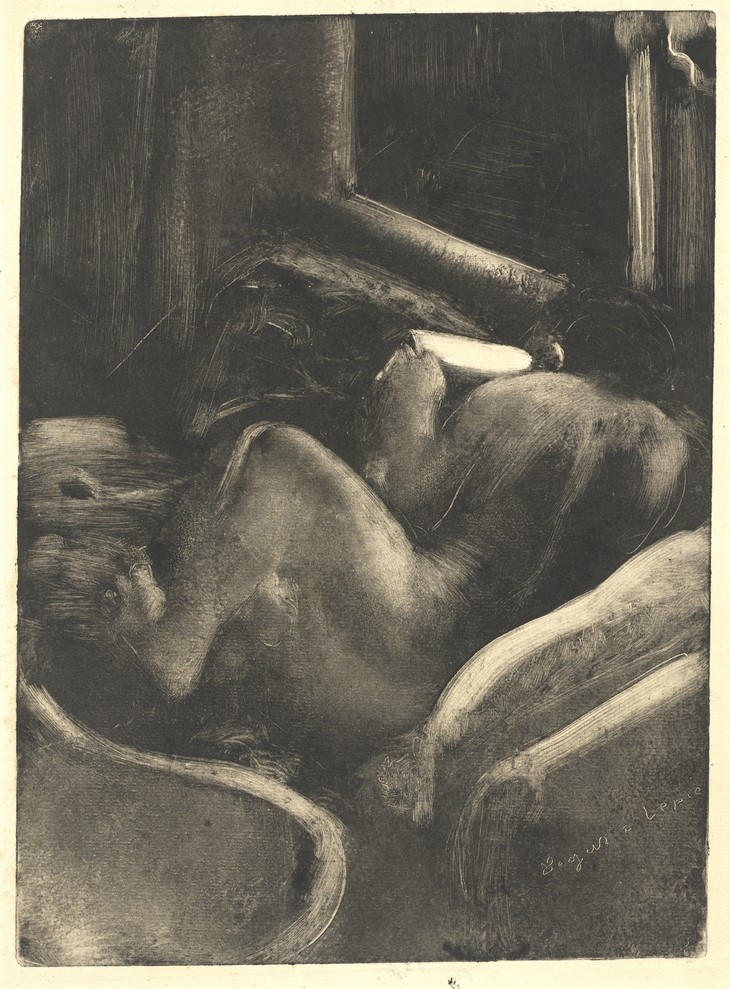 EDGAR DEGAS (FRENCH, 1834?1917). WOMAN READING (LISEUSE), C. 1880?85. MONOTYPE ON PAPER. PLATE: 14 15/16 X 10 7/8 IN. (38 X 27.7 CM), SHEET: 17 7/16 X 12 13/16 IN. (44.3 X 32.5 CM). NATIONAL GALLERY OF ART, WASHINGTON, D.C. ROSENWALD COLLECTION, 1950.
EDGAR DEGAS (FRENCH, 1834?1917). WOMAN READING (LISEUSE), C. 1880?85. MONOTYPE ON PAPER. PLATE: 14 15/16 X 10 7/8 IN. (38 X 27.7 CM), SHEET: 17 7/16 X 12 13/16 IN. (44.3 X 32.5 CM). NATIONAL GALLERY OF ART, WASHINGTON, D.C. ROSENWALD COLLECTION, 1950.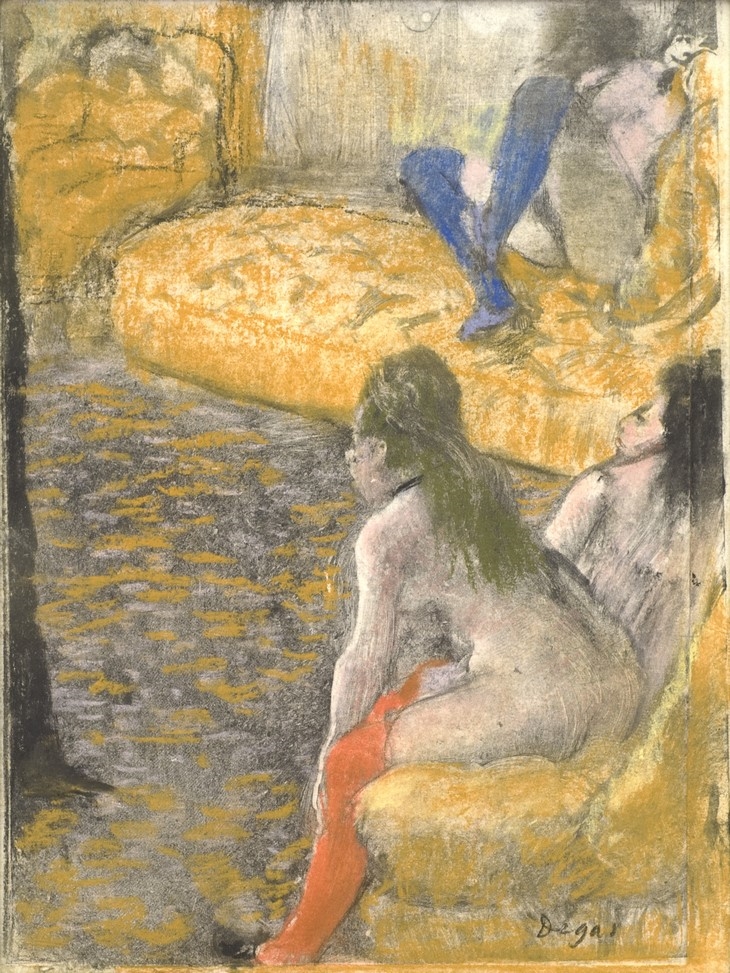 EDGAR DEGAS (FRENCH, 1834?1917). WAITING FOR A CLIENT, 1879. CHARCOAL AND PASTEL OVER MONOTYPE ON PAPER. PLATE: 6 3/8 × 4 3/4 IN. (16.2 × 12.1 CM). PRIVATE COLLECTION.
EDGAR DEGAS (FRENCH, 1834?1917). WAITING FOR A CLIENT, 1879. CHARCOAL AND PASTEL OVER MONOTYPE ON PAPER. PLATE: 6 3/8 × 4 3/4 IN. (16.2 × 12.1 CM). PRIVATE COLLECTION.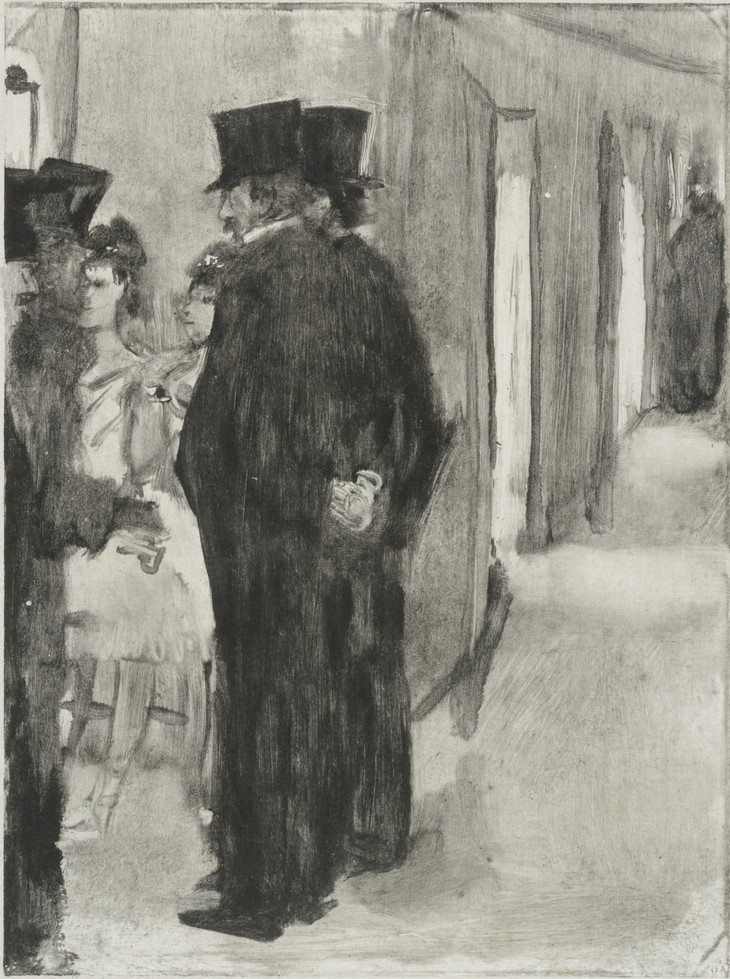 EDGAR DEGAS (FRENCH, 1834?1917). PAULINE AND VIRGINIE CONVERSING WITH ADMIRERS (PAULINE ET VIRGINIE CARDINAL BAVARDANT AVEC DES ADMIRATEURS), C. 1876?77. PROPOSED ILLUSTRATION FOR THE CARDINAL FAMILY (LA FAMILLE CARDINAL). MONOTYPE ON PAPER. PLATE: 8 7/16 X 6 5/16 IN. (21.5 X 16.1 CM); SHEET: 11 3/10 X 7 1/2 IN. (28.7 X 19.1 CM). HARVARD ART MUSEUMS/FOGG MUSEUM, CAMBRIDGE, MASSACHUSETTS. BEQUEST OF META AND PAUL J. SACHS.
EDGAR DEGAS (FRENCH, 1834?1917). PAULINE AND VIRGINIE CONVERSING WITH ADMIRERS (PAULINE ET VIRGINIE CARDINAL BAVARDANT AVEC DES ADMIRATEURS), C. 1876?77. PROPOSED ILLUSTRATION FOR THE CARDINAL FAMILY (LA FAMILLE CARDINAL). MONOTYPE ON PAPER. PLATE: 8 7/16 X 6 5/16 IN. (21.5 X 16.1 CM); SHEET: 11 3/10 X 7 1/2 IN. (28.7 X 19.1 CM). HARVARD ART MUSEUMS/FOGG MUSEUM, CAMBRIDGE, MASSACHUSETTS. BEQUEST OF META AND PAUL J. SACHS.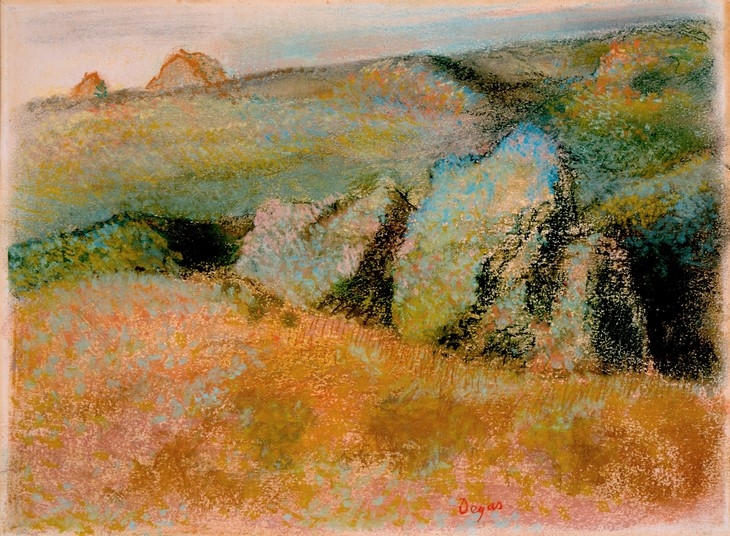 EDGAR DEGAS (FRENCH, 1834?1917). LANDSCAPE WITH ROCKS (PAYSAGE AVEC ROCHERS), 1892. PASTEL OVER MONOTYPE IN OIL ON WOVE PAPER. SHEET: 10 1/8 × 13 9/16? (25.7 × 34.4 CM). HIGH MUSEUM OF ART, ATLANTA, PURCHASE WITH HIGH MUSEUM OF ART ENHANCEMENT FUND.
EDGAR DEGAS (FRENCH, 1834?1917). LANDSCAPE WITH ROCKS (PAYSAGE AVEC ROCHERS), 1892. PASTEL OVER MONOTYPE IN OIL ON WOVE PAPER. SHEET: 10 1/8 × 13 9/16? (25.7 × 34.4 CM). HIGH MUSEUM OF ART, ATLANTA, PURCHASE WITH HIGH MUSEUM OF ART ENHANCEMENT FUND.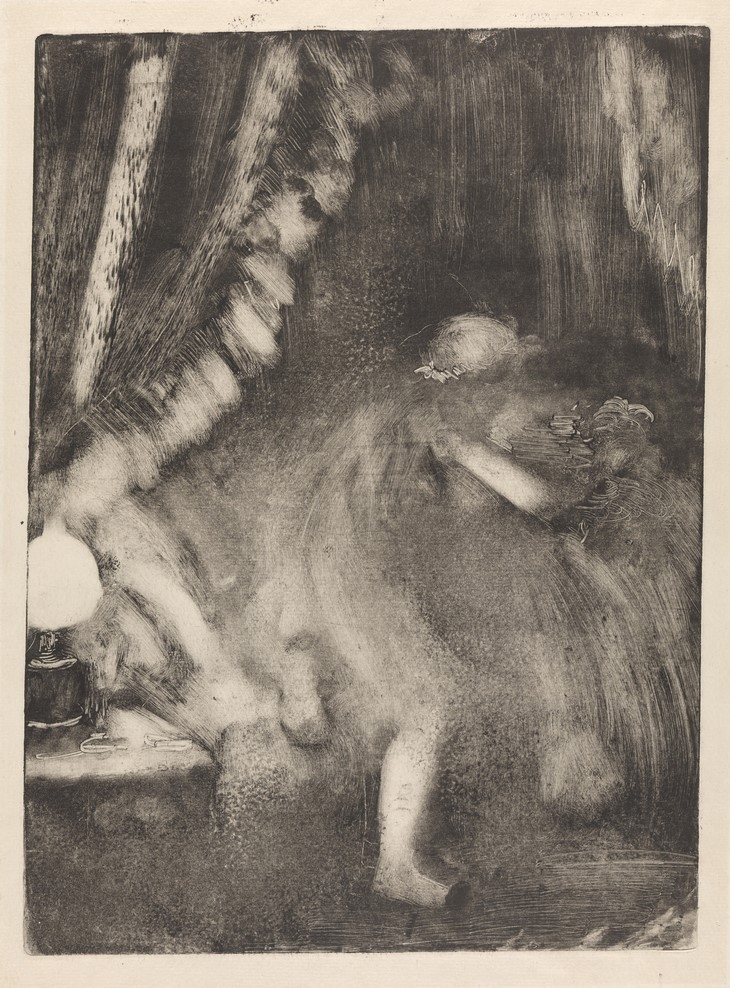 EDGAR DEGAS (FRENCH, 1834?1917). BEDTIME (LE COUCHER), C. 1880-85. MONOTYPE ON PAPER. PLATE: 14 7/8 × 10 7/8? (37.8 × 27.7 CM). NASJONALMUSEET FOR KUNST, ARKITEKTUR OG DESIGN / THE NATIONAL MUSEUM OF ART, ARCHITECTURE AND DESIGN.
EDGAR DEGAS (FRENCH, 1834?1917). BEDTIME (LE COUCHER), C. 1880-85. MONOTYPE ON PAPER. PLATE: 14 7/8 × 10 7/8? (37.8 × 27.7 CM). NASJONALMUSEET FOR KUNST, ARKITEKTUR OG DESIGN / THE NATIONAL MUSEUM OF ART, ARCHITECTURE AND DESIGN.![Archisearch - Edgar Degas (French, 1834–1917). The Fireside (Le Foyer [La Cheminée]), c. 1880–85. Monotype on paper. Plate: 16 3/4 x 23 1/16 in. (42.5 x 58.6 cm), sheet: 19 3/4 x 25 1/2 in. (50.2 x 64.8 cm). The Metropolitan Museum of Art, New York. Harris Brisbane Dick Fund, The Elisha Whittelsey Collection, The Elisha Whittelsey Fund, and C. Douglas Dillon Gift, 1968 (68.670).](https://www.archisearch.gr/wp-content/uploads/old-site/degas-in-moma-6.jpg) EDGAR DEGAS (FRENCH, 1834?1917). THE FIRESIDE (LE FOYER [LA CHEMINÉE]), C. 1880?85. MONOTYPE ON PAPER. PLATE: 16 3/4 X 23 1/16 IN. (42.5 X 58.6 CM), SHEET: 19 3/4 X 25 1/2 IN. (50.2 X 64.8 CM). THE METROPOLITAN MUSEUM OF ART, NEW YORK. HARRIS BRISBANE DICK FUND, THE ELISHA WHITTELSEY COLLECTION, THE ELISHA WHITTELSEY FUND, AND C. DOUGLAS DILLON GIFT, 1968 (68.670).
EDGAR DEGAS (FRENCH, 1834?1917). THE FIRESIDE (LE FOYER [LA CHEMINÉE]), C. 1880?85. MONOTYPE ON PAPER. PLATE: 16 3/4 X 23 1/16 IN. (42.5 X 58.6 CM), SHEET: 19 3/4 X 25 1/2 IN. (50.2 X 64.8 CM). THE METROPOLITAN MUSEUM OF ART, NEW YORK. HARRIS BRISBANE DICK FUND, THE ELISHA WHITTELSEY COLLECTION, THE ELISHA WHITTELSEY FUND, AND C. DOUGLAS DILLON GIFT, 1968 (68.670).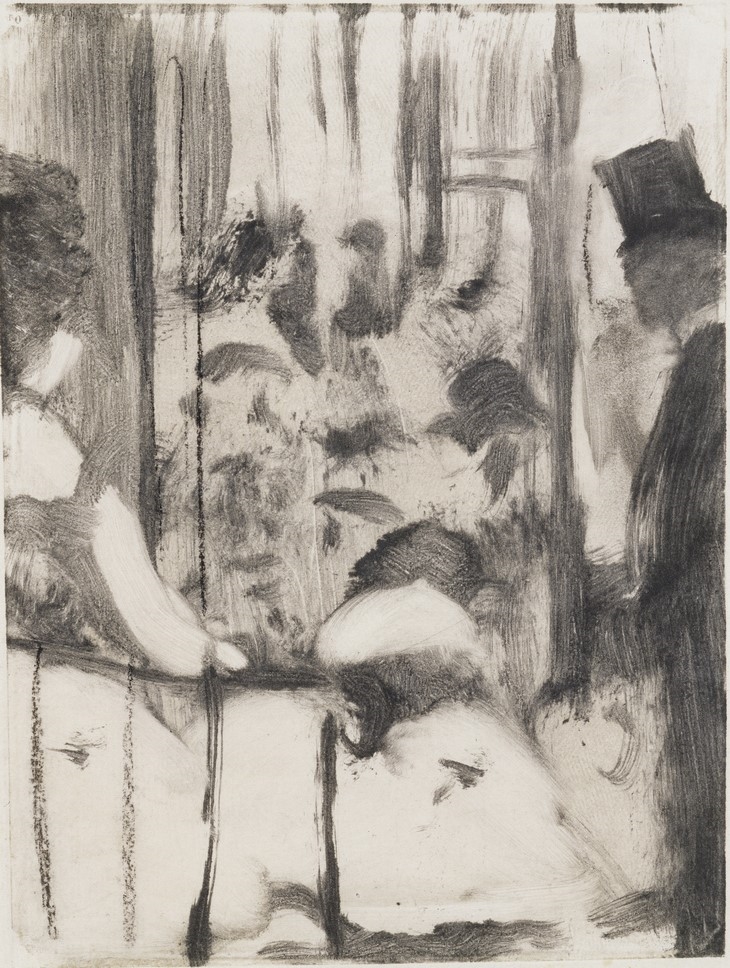 EDGAR DEGAS (FRENCH, 1834?1917). DANCERS COMING FROM THE DRESSING ROOMS ONTO THE STAGE (ET CES DEMOISELLES FRETILLAIENT GENTIMENT DEVANT LA GLACE DU FOYER), C. 1876?77. PROPOSED ILLUSTRATION FOR THE CARDINAL FAMILY (LA FAMILLE CARDINAL). PASTEL OVER MONOTYPE ON PAPER. PLATE: 8 3/8 × 6 1/4 IN. (21.2 × 15.8 CM). SCHORR COLLECTION.
EDGAR DEGAS (FRENCH, 1834?1917). DANCERS COMING FROM THE DRESSING ROOMS ONTO THE STAGE (ET CES DEMOISELLES FRETILLAIENT GENTIMENT DEVANT LA GLACE DU FOYER), C. 1876?77. PROPOSED ILLUSTRATION FOR THE CARDINAL FAMILY (LA FAMILLE CARDINAL). PASTEL OVER MONOTYPE ON PAPER. PLATE: 8 3/8 × 6 1/4 IN. (21.2 × 15.8 CM). SCHORR COLLECTION.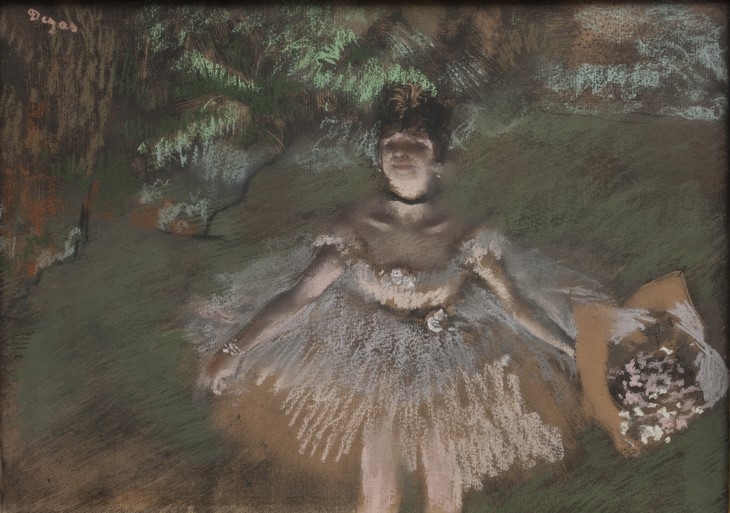 EDGAR DEGAS (FRENCH, 1834?1917). DANCER ONSTAGE WITH A BOUQUET, C.1876. PASTEL OVER MONOTYPE ON LAID PAPER. PLATE: 10 5/8 × 14 7/8 IN. (27 × 37.8 CM). PRIVATE COLLECTION.
EDGAR DEGAS (FRENCH, 1834?1917). DANCER ONSTAGE WITH A BOUQUET, C.1876. PASTEL OVER MONOTYPE ON LAID PAPER. PLATE: 10 5/8 × 14 7/8 IN. (27 × 37.8 CM). PRIVATE COLLECTION.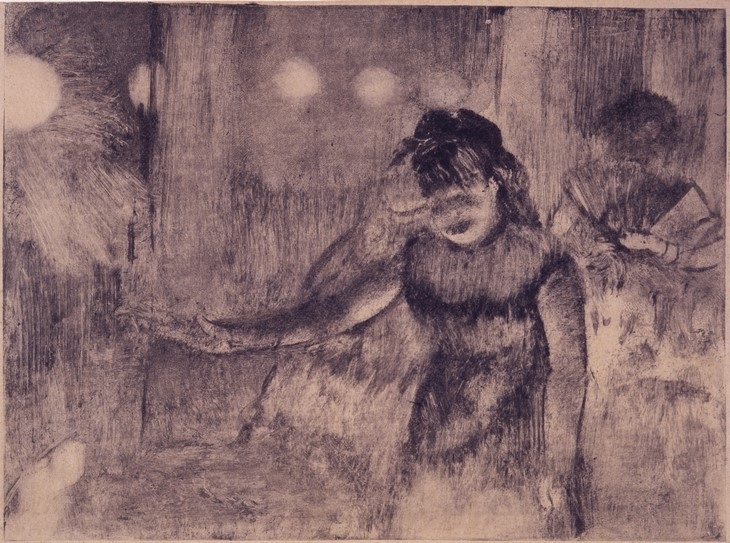 EDGAR DEGAS (FRENCH, 1834?1917). CAFÉ SINGER, C.1877?78. MONOTYPE ON PAPER. PLATE: 4 3/4 × 6 3/8 IN. (12 × 16.2 CM). PRIVATE COLLECTION.
EDGAR DEGAS (FRENCH, 1834?1917). CAFÉ SINGER, C.1877?78. MONOTYPE ON PAPER. PLATE: 4 3/4 × 6 3/8 IN. (12 × 16.2 CM). PRIVATE COLLECTION.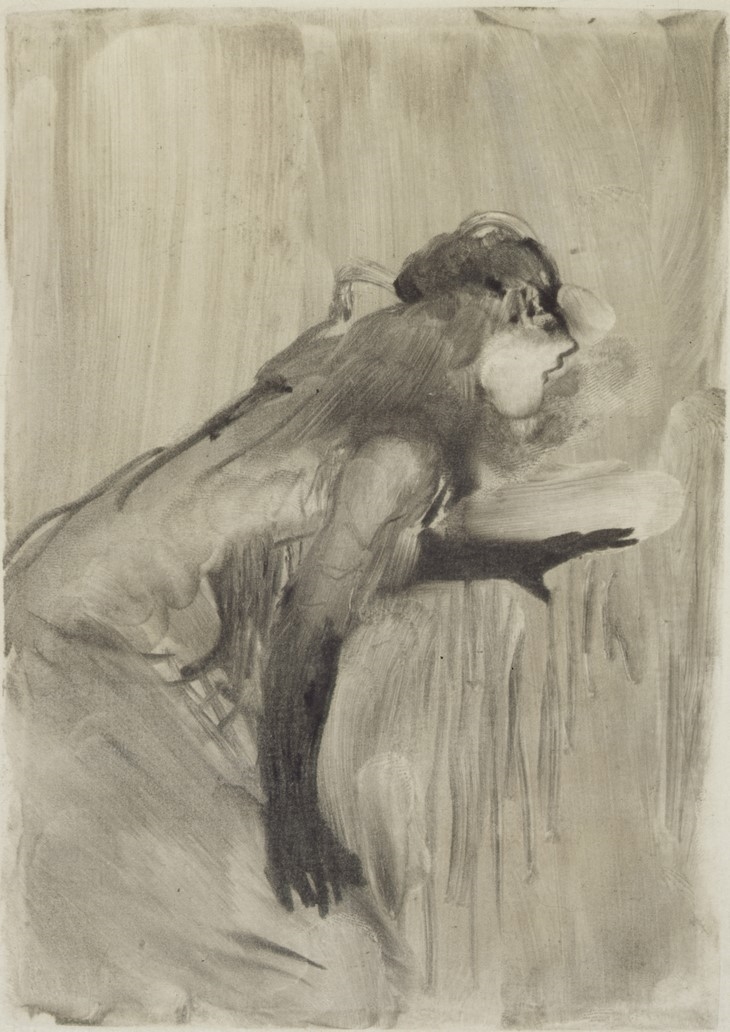 EDGAR DEGAS (FRENCH, 1834?1917). CAFÉ-CONCERT SINGER (CHANTEUSE DE CAFÉ-CONCERT), C. 1877. MONOTYPE ON PAPER MOUNTED ON BOARD. PLATE: 7 5/16 X 5 1/16 IN. (18.5 X 12.8 CM), SHEET: 9 1/4 X 7 1/16 IN. (23.5 X 18 CM). PRIVATE COLLECTION.
EDGAR DEGAS (FRENCH, 1834?1917). CAFÉ-CONCERT SINGER (CHANTEUSE DE CAFÉ-CONCERT), C. 1877. MONOTYPE ON PAPER MOUNTED ON BOARD. PLATE: 7 5/16 X 5 1/16 IN. (18.5 X 12.8 CM), SHEET: 9 1/4 X 7 1/16 IN. (23.5 X 18 CM). PRIVATE COLLECTION.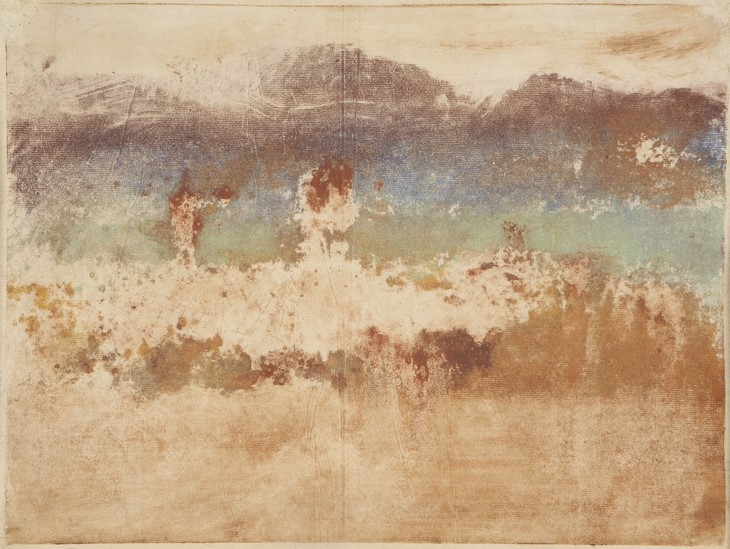 EDGAR DEGAS (FRENCH, 1834?1917). AUTUMN LANDSCAPE (L?ESTÉREL), 1890. MONOTYPE IN OIL ON PAPER. PLATE: 11 7/8 X 15 5/8 IN. (30.2 X 39.7 CM), SHEET: 12 1/8 X 16 1/16 IN. (30.8 X 40.8 CM). NORTON SIMON MUSEUM, PASADENA, CALIFORNIA. MUSEUM PURCHASE, B. GERALD CANTOR FUND.
EDGAR DEGAS (FRENCH, 1834?1917). AUTUMN LANDSCAPE (L?ESTÉREL), 1890. MONOTYPE IN OIL ON PAPER. PLATE: 11 7/8 X 15 5/8 IN. (30.2 X 39.7 CM), SHEET: 12 1/8 X 16 1/16 IN. (30.8 X 40.8 CM). NORTON SIMON MUSEUM, PASADENA, CALIFORNIA. MUSEUM PURCHASE, B. GERALD CANTOR FUND.READ ALSO: ΚΑΛΕΣΜΑ – ΠΛΑΙΣΙΟ ΕΛΛΗΝΙΚΗΣ ΣΥΜΜΕΤΟΧΗΣ ΑΠΟ ΤΟΝ ΣΑΔΑΣ-ΠΕΑ